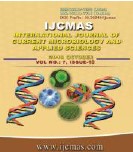


 National Academy of Agricultural Sciences (NAAS)
National Academy of Agricultural Sciences (NAAS)

|
PRINT ISSN : 2319-7692
Online ISSN : 2319-7706 Issues : 12 per year Publisher : Excellent Publishers Email : editorijcmas@gmail.com / submit@ijcmas.com Editor-in-chief: Dr.M.Prakash Index Copernicus ICV 2018: 95.39 NAAS RATING 2020: 5.38 |
Mandible was the largest bone of the skull. It was a single bone and consisted of two halves that articulated cranially at intermandibular symphysis. The mandible lodged all the lower teeth. The body was concave dorsoventrally and presented three alveoli for incisors and a large alveolus for canine in each half of the mandible. The labial surface was more extensive than lingual surface. The symphaseal surface faced each other and formed intemandibular symphysis. It was rough and irregular. The rami were right and left and were symmetrical. Each ramus was flattened from side to side. The two rami diverge to form a large “V” shaped mandibular space. The horizontal part of rami was of same height from the level of 1st to last cheek tooth. The lateral surface of horizontal part presented two distinct mental foramina out of which the cranial mental foramen was located just in front of cheek tooth and was larger as compared to caudal mental foramen. The alveolar border was nearly straight. A wide space, diastema, separated the canine from 1st premolar. This border presented alveoli for two premolars and a single molar tooth each with two roots. The posterior border was thick, convex and rounded. It continued posteriorly to form angular process. The vertical ramus was much thinner as compared to horizontal part due to presence of a masseteric fossa on its lateral surface. It was roughly triangular in outline. Medially, the vertical ramus presented mandibular foramen. Both the mandibular and mental foramen was located at about the same level. The articular extremity of vertical ramus presented a non-articular coronoid process and an articular condyle separated by mandibular notch. Coronoid process was flattened from side to side. The condyle was transversely elongated convex articular process that formed temporo-mandibular articulation with squamous temporal bone.
 |
 |
 |
 |
 |